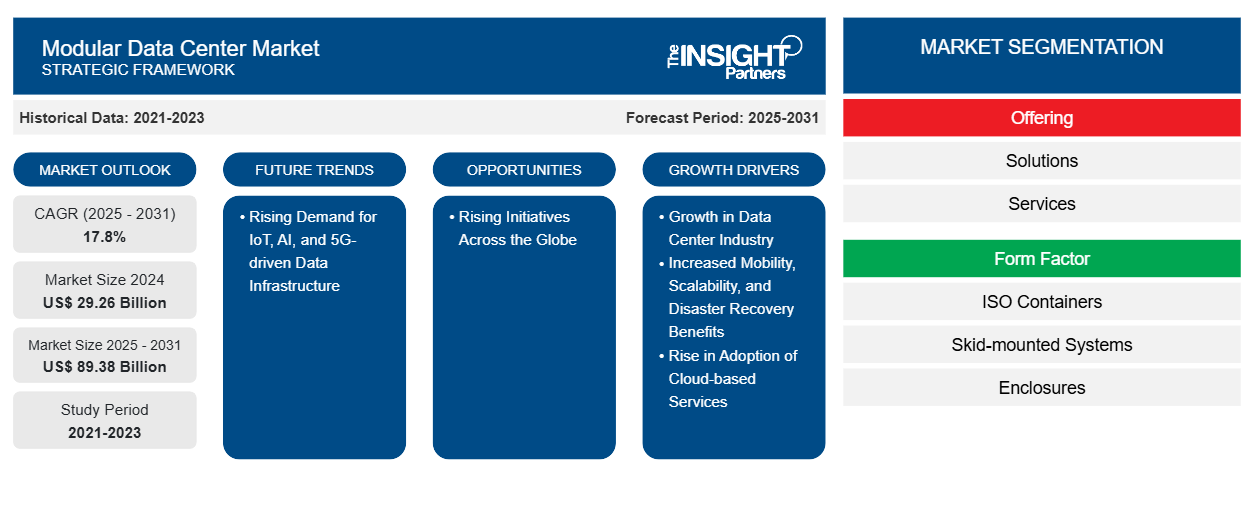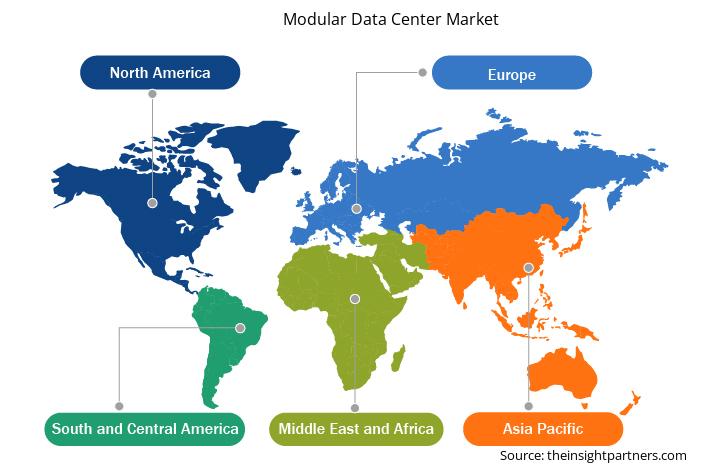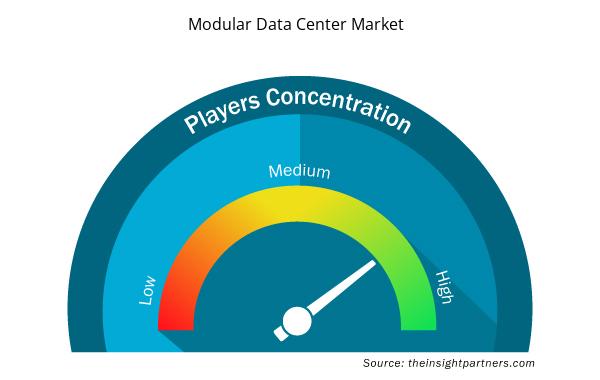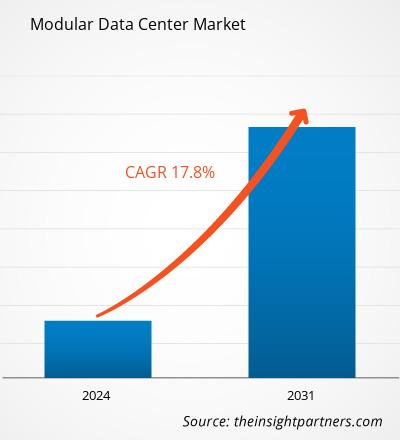La dimensione del mercato dei data center modulari è stata valutata a 29,26 miliardi di dollari nel 2024 e si prevede che raggiungerà gli 89,38 miliardi di dollari entro il 2031; si stima che registrerà un CAGR del 17,8% nel periodo 2025-2031. La crescente domanda di infrastrutture dati basate su IoT, AI e 5G sarà probabilmente una tendenza chiave nel mercato durante il periodo di previsione.
Analisi di mercato dei data center modulari
La crescita del mercato globale dei data center modulari è stata guidata dai suoi vantaggi in termini di mobilità, scalabilità e disaster recovery. Queste innovazioni sono progettate per fornire soluzioni rapide e flessibili, consentendo alle aziende di implementare sistemi IT. Le organizzazioni richiedono garanzie in merito alla continuità operativa e alla capacità di riprendersi da potenziali interruzioni. Il mercato offre varie soluzioni con strutture robuste che possono essere facilmente trasferite o ampliate per soddisfare i requisiti specifici di un'azienda. Questa flessibilità è fondamentale per mantenere la continuità aziendale durante disastri o altri eventi imprevisti, garantendo la protezione dei loro dati e delle loro applicazioni.
Panoramica del mercato dei data center modulari
Un data center modulare è un approccio scalabile e flessibile per la gestione dell'infrastruttura IT, in cui i singoli componenti o moduli sono unità pre-progettate e prefabbricate che possono essere assemblate ed espanse in base alle necessità. A differenza dei data center tradizionali, che richiedono grandi progetti di costruzione centralizzati, i data center modulari sono costruiti utilizzando unità standardizzate che possono essere rapidamente distribuite e personalizzate. Questa modularità consente alle aziende di aggiungere più capacità nel tempo senza interruzioni significative o grandi investimenti iniziali. I data center modulari offrono diversi vantaggi chiave. Forniscono scalabilità, consentendo alle aziende di aumentare la propria capacità di elaborazione dati con le crescenti esigenze. Ciò li rende particolarmente preziosi per le aziende che sperimentano una rapida crescita o una domanda fluttuante. La progettazione modulare garantisce inoltre che le aziende possano espandere la propria infrastruttura IT in modo incrementale, riducendo al minimo i costi non necessari e prevenendo l'eccesso di provisioning. La domanda di soluzioni flessibili e portatili è in aumento poiché le aziende si sforzano di adattarsi alle mutevoli esigenze del mercato. I data center modulari consentono alle aziende di espandere la propria infrastruttura in base alle necessità, con tempi di inattività inferiori rispetto ai data center tradizionali. Questa flessibilità è particolarmente vantaggiosa per settori come la vendita al dettaglio, in cui la domanda fluttua, o per le aziende che entrano in nuovi mercati. Poiché flessibilità e rapidità di risposta stanno diventando essenziali per il successo aziendale, i data center modulari sono sempre più considerati risorse preziose che aiutano le organizzazioni ad affrontare efficacemente le sfide e ottimizzare le proprie operazioni.
Personalizza questo report in base alle tue esigenze
Riceverai la personalizzazione gratuita di qualsiasi report, comprese parti di questo report, o analisi a livello nazionale, pacchetto dati Excel, oltre a usufruire di grandi offerte e sconti per start-up e università
Mercato dei data center modulari: approfondimenti strategici

- Scopri le principali tendenze di mercato in questo rapporto.Questo campione GRATUITO includerà analisi di dati che spaziano dalle tendenze di mercato alle stime e alle previsioni.
Driver e opportunità del mercato dei data center modulari
Crescita nel settore dei data center
Il settore dei data center ha registrato una crescita significativa nell'ultimo decennio, guidata dal crescente consumo di dati, dall'adozione del cloud e dalla proliferazione di dispositivi IoT. Secondo JLL, a settembre 2024, il settore dei data center sta riscontrando una domanda travolgente da parte degli utenti. A metà del 2024, la capacità disponibile dei data center di colocation negli Stati Uniti aveva raggiunto i 12 GW, raddoppiando dal 2020, con un tasso di crescita annuale composto del 21%. La Virginia settentrionale continua a guidare come il mercato più grande, rappresentando quasi la metà dell'espansione della capacità dal 2020 e superando altre regioni con un margine significativo. Tuttavia, i mercati negli Stati Uniti meridionali e occidentali hanno osservato una crescita più rapida. Man mano che le organizzazioni e le aziende continuano ad espandere la propria infrastruttura digitale, la necessità di una gestione efficiente e affidabile di sistemi IT complessi è aumentata. Ciò ha dato origine alla crescente domanda di data center modulari, che svolgono un ruolo fondamentale nel consentire una gestione senza interruzioni delle operazioni dei data center.
Aumento dell'adozione di servizi basati su cloud
I governi e le grandi aziende stanno dando priorità all'implementazione di soluzioni e applicazioni cloud avanzate . I principali attori del settore si stanno concentrando sullo sviluppo di data center modulari all'avanguardia dotati di tecnologie immersive per gestire grandi quantità di dati. Ad esempio, a luglio 2025, Vertiv, leader mondiale nelle soluzioni di continuità e infrastrutture digitali critiche, ha introdotto Vertiv MegaMod CoolChip, una soluzione di data center modulare prefabbricata (PFM) dotata di raffreddamento a liquido, progettata per supportare un computing AI efficiente e affidabile . Questa soluzione può essere personalizzata per adattarsi alle piattaforme dei principali provider di computing AI e ridimensionata in base alle esigenze del cliente. Combinando l'approccio di alta qualità ed efficienza di processo della fabbricazione fuori sede con tecnologie avanzate pronte per l'AI, MegaMod CoolChip può ridurre i tempi di distribuzione per l'infrastruttura digitale critica per l'AI fino al 50%.
Analisi della segmentazione del rapporto di mercato dei data center modulari
I segmenti chiave che hanno contribuito alla derivazione dell'analisi di mercato dei data center modulari sono l'offerta, le soluzioni, il fattore di forma, le dimensioni dell'organizzazione e il settore verticale.
- In termini di offerta, il mercato si divide in soluzioni e servizi.
- In base alle soluzioni, il mercato è segmentato in moduli prefabbricati e soluzioni all-in-one.
- In termini di fattore di forma, il mercato è suddiviso in contenitori ISO, sistemi montati su skid e contenitori.
- In base alle dimensioni dell'organizzazione, il mercato si divide in PMI e grandi imprese.
- In base al settore verticale, il mercato è suddiviso in IT e telecomunicazioni, BFSI, pubblica amministrazione, sanità, produzione, media e intrattenimento e altri.
Analisi della quota di mercato dei data center modulari per area geografica
- Il mercato dei data center modulari è suddiviso in cinque regioni principali: Nord America, Europa, Asia Pacifico (APAC), Medio Oriente e Africa (MEA) e Sud e Centro America. Il Nord America ha dominato il mercato nel 2024, seguito da Europa e Asia Pacifico.
- Il mercato dei data center modulari in Nord America è suddiviso in Stati Uniti, Canada e Messico. La rapida espansione delle applicazioni ad alta intensità di dati e del cloud computing ha portato a un notevole aumento del numero di data center nella regione. Secondo l'analisi delle tendenze dei data center del Nord America di CBRE del 2024, i sette principali mercati dei data center in Nord America sono operativi negli Stati Uniti, ovvero nella Virginia settentrionale, Dallas/Fort Worth, Silicon Valley, Chicago, Phoenix, New York Tri-State Area e Atlanta. La rapida adozione di tecnologie di cloud computing, IoT, AI e 5G sta alimentando la domanda di data center scalabili ed efficienti in Nord America. Queste tecnologie richiedono un'infrastruttura solida, flessibile e affidabile, rendendo i data center modulari una soluzione ideale. I data center modulari forniscono la scalabilità necessaria per accogliere i crescenti volumi di dati, consentendo alle aziende di ampliare rapidamente la propria infrastruttura per soddisfare le mutevoli esigenze.
- La necessità di elaborazione dati localizzata a bassa latenza sta diventando sempre più critica, soprattutto con l'ascesa dell'IoT e delle applicazioni di dati in tempo reale. I data center modulari offrono una soluzione consentendo alle aziende di implementare unità più piccole e distribuite geograficamente che riducono la latenza e migliorano le prestazioni. Ciò è particolarmente importante in settori come l'automotive, l'assistenza sanitaria e la produzione, dove l'elaborazione dati in tempo reale è fondamentale per l'efficienza operativa. Allo stesso modo, la crescente tendenza dell'edge computing in Nord America è un fattore chiave per l'adozione di data center modulari. Mentre le aziende spingono per una maggiore potenza di elaborazione più vicina alla fonte di generazione dei dati, i data center modulari offrono la flessibilità e le capacità di distribuzione rapida richieste per le applicazioni di edge computing.
- Vertiv Group, Schneider Electric ed Emerson sono alcune delle aziende di spicco nel mercato dei data center modulari in Europa. Questi pagatori stanno adottando varie iniziative per sviluppare data center modulari. A novembre 2024, Schneider Electric, leader nella trasformazione digitale della gestione dell'energia e dell'automazione, ha notevolmente ampliato la capacità di produzione e fabbricazione del suo stabilimento di data center prefabbricati di Barcellona, passando da 7.000 m2 a 12.000 m2 in risposta alla crescente domanda dei clienti di soluzioni di data center prefabbricate ad alto carico di lavoro. Lo stabilimento e il centro logistico su larga scala, situati a Sant Boi de Llobregat, Barcellona, una delle sedi principali in Europa per la progettazione, la produzione e l'integrazione del portafoglio EcoStruxure Modular Data Center di Schneider Electric, offrono altri 5.000 m2 di spazio di produzione dedicato, soddisfacendo i requisiti accelerati dei clienti in termini di rapidità di immissione sul mercato, prevedibilità e soluzioni di data center resilienti.
Approfondimenti regionali sul mercato dei data center modulari
Le tendenze regionali e i fattori che influenzano il mercato dei data center modulari durante il periodo di previsione sono stati ampiamente spiegati dagli analisti di Insight Partners. Questa sezione discute anche i segmenti e la geografia del mercato dei data center modulari in Nord America, Europa, Asia Pacifico, Medio Oriente e Africa e America centrale e meridionale.

- Ottieni i dati specifici regionali per il mercato dei data center modulari
Ambito del rapporto sul mercato dei data center modulari
| Attributo del report | Dettagli |
|---|---|
| Dimensioni del mercato nel 2024 | 29,26 miliardi di dollari USA |
| Dimensioni del mercato entro il 2031 | 89,38 miliardi di dollari USA |
| CAGR globale (2025 - 2031) | 17,8% |
| Dati storici | 2021-2023 |
| Periodo di previsione | 2025-2031 |
| Segmenti coperti | Offrendo
|
| Regioni e Paesi coperti | America del Nord
|
| Leader di mercato e profili aziendali chiave |
|
Attori del mercato dei data center modulari Densità: comprendere il suo impatto sulle dinamiche aziendali
Il mercato del mercato dei data center modulari sta crescendo rapidamente, spinto dalla crescente domanda degli utenti finali dovuta a fattori quali l'evoluzione delle preferenze dei consumatori, i progressi tecnologici e una maggiore consapevolezza dei vantaggi del prodotto. Con l'aumento della domanda, le aziende stanno ampliando le loro offerte, innovando per soddisfare le esigenze dei consumatori e capitalizzando sulle tendenze emergenti, il che alimenta ulteriormente la crescita del mercato.
La densità degli operatori di mercato si riferisce alla distribuzione di aziende o società che operano in un particolare mercato o settore. Indica quanti concorrenti (operatori di mercato) sono presenti in un dato spazio di mercato in relazione alle sue dimensioni o al valore di mercato totale.
Le principali aziende che operano nel mercato dei data center modulari sono:
- Schneider Electric Italia
- Società a responsabilità limitata PCX
- Huawei Digital Power Technologies Co Ltd
- Delta Elettronica Inc.
- Rittal GmbH & Co KG
- Eaton Corporation Plc
Disclaimer : le aziende elencate sopra non sono classificate secondo un ordine particolare.

- Ottieni una panoramica dei principali attori del mercato dei data center modulari
Notizie di mercato e sviluppi recenti sui data center modulari
Il mercato dei data center modulari viene valutato raccogliendo dati qualitativi e quantitativi dopo la ricerca primaria e secondaria, che include importanti pubblicazioni aziendali, dati associativi e database. Di seguito sono elencati alcuni degli sviluppi nel mercato dei data center modulari:
- Eaton e CTS Nordics, un'azienda che progetta e costruisce data center, stanno realizzando una nuova struttura NordicEPOD a Oslo. La struttura all'avanguardia di NordicEPOD ora produce moduli di potenza standardizzati noti come EPOD, che riducono di settimane i tempi di costruzione dei data center.
(Fonte: Eaton, Comunicato stampa, 2025)
- Schneider Electric, leader mondiale nella trasformazione digitale della gestione dell'energia e dell'automazione, ha inaugurato un nuovo stabilimento di integrazione di 105.000 piedi quadrati a Red Oak, in Texas, che verrà utilizzato per realizzare un'infrastruttura modulare prefabbricata per soddisfare la crescente domanda di nuovi data center negli Stati Uniti.
(Fonte: Schneider Electric, Comunicato stampa, 2024)
Copertura e risultati del rapporto sul mercato dei data center modulari
“Dimensioni e previsioni del mercato dei data center modulari (2021-2031)” fornisce un’analisi dettagliata del mercato che copre le aree menzionate di seguito:
- Dimensioni e previsioni del mercato dei data center modulari a livello globale, regionale e nazionale per tutti i segmenti di mercato chiave coperti dall'ambito
- Tendenze del mercato dei data center modulari, nonché dinamiche di mercato quali driver, vincoli e opportunità chiave
- Analisi PEST e SWOT dettagliate
- Analisi di mercato dei data center modulari che copre le principali tendenze di mercato, il quadro globale e regionale, i principali attori, le normative e i recenti sviluppi del mercato
- Analisi del panorama industriale e della concorrenza che copre la concentrazione del mercato, l'analisi della mappa di calore, i principali attori e gli sviluppi recenti per il mercato dei data center modulari
- Profili aziendali dettagliati
- Analisi storica (2 anni), anno base, previsione (7 anni) con CAGR
- Analisi PEST e SWOT
- Valore/volume delle dimensioni del mercato - Globale, regionale, nazionale
- Industria e panorama competitivo
- Set di dati Excel



Report Coverage
Revenue forecast, Company Analysis, Industry landscape, Growth factors, and Trends

Segment Covered
This text is related
to segments covered.

Regional Scope
North America, Europe, Asia Pacific, Middle East & Africa, South & Central America

Country Scope
This text is related
to country scope.
Domande frequenti
The key players, holding majority shares, in modular data center market includes Huawei Technologies Co., Ltd., Dell Inc., Schneider Electric, Hewlett Packard Enterprise Development LP, and ABB Ltd.
The North America held the largest market share in 2024, followed by Europe.
The modular data center market was valued at US$ 29.25 billion in 2024 and is projected to reach US$ 89.37 billion by 2031; it is expected to grow at a CAGR of 17.8% during 2025–2031.
Growth in data center industry and increased mobility, scalability, and disaster recovery benefits, and rise in adoption of cloud-based services are the driving factors impacting the modular data center market.
Rising Demand for IoT, AI, and 5G-driven Data Infrastructure is the future trends of the modular data center market.
The modular data center market is expected to reach US$ 89.37 billion in the year 2031.
Trends and growth analysis reports related to Technology, Media and Telecommunications : READ MORE..
The List of Companies - Modular Data Center Market
- Schneider Electric SE
- PCX Holding LLC
- Huawei Digital Power Technologies Co Ltd
- Delta Electronics Inc
- Rittal GmbH & Co KG
- Eaton Corp Plc
- Dell Technologies Inc
- Vertiv Group Corp.
- Hewlett Packard Enterprise Development LP
- ABB Ltd
The Insight Partners performs research in 4 major stages: Data Collection & Secondary Research, Primary Research, Data Analysis and Data Triangulation & Final Review.
- Data Collection and Secondary Research:
As a market research and consulting firm operating from a decade, we have published and advised several client across the globe. First step for any study will start with an assessment of currently available data and insights from existing reports. Further, historical and current market information is collected from Investor Presentations, Annual Reports, SEC Filings, etc., and other information related to company’s performance and market positioning are gathered from Paid Databases (Factiva, Hoovers, and Reuters) and various other publications available in public domain.
Several associations trade associates, technical forums, institutes, societies and organization are accessed to gain technical as well as market related insights through their publications such as research papers, blogs and press releases related to the studies are referred to get cues about the market. Further, white papers, journals, magazines, and other news articles published in last 3 years are scrutinized and analyzed to understand the current market trends.
- Primary Research:
The primarily interview analysis comprise of data obtained from industry participants interview and answers to survey questions gathered by in-house primary team.
For primary research, interviews are conducted with industry experts/CEOs/Marketing Managers/VPs/Subject Matter Experts from both demand and supply side to get a 360-degree view of the market. The primary team conducts several interviews based on the complexity of the markets to understand the various market trends and dynamics which makes research more credible and precise.
A typical research interview fulfils the following functions:
- Provides first-hand information on the market size, market trends, growth trends, competitive landscape, and outlook
- Validates and strengthens in-house secondary research findings
- Develops the analysis team’s expertise and market understanding
Primary research involves email interactions and telephone interviews for each market, category, segment, and sub-segment across geographies. The participants who typically take part in such a process include, but are not limited to:
- Industry participants: VPs, business development managers, market intelligence managers and national sales managers
- Outside experts: Valuation experts, research analysts and key opinion leaders specializing in the electronics and semiconductor industry.
Below is the breakup of our primary respondents by company, designation, and region:

Once we receive the confirmation from primary research sources or primary respondents, we finalize the base year market estimation and forecast the data as per the macroeconomic and microeconomic factors assessed during data collection.
- Data Analysis:
Once data is validated through both secondary as well as primary respondents, we finalize the market estimations by hypothesis formulation and factor analysis at regional and country level.
- Macro-Economic Factor Analysis:
We analyse macroeconomic indicators such the gross domestic product (GDP), increase in the demand for goods and services across industries, technological advancement, regional economic growth, governmental policies, the influence of COVID-19, PEST analysis, and other aspects. This analysis aids in setting benchmarks for various nations/regions and approximating market splits. Additionally, the general trend of the aforementioned components aid in determining the market's development possibilities.
- Country Level Data:
Various factors that are especially aligned to the country are taken into account to determine the market size for a certain area and country, including the presence of vendors, such as headquarters and offices, the country's GDP, demand patterns, and industry growth. To comprehend the market dynamics for the nation, a number of growth variables, inhibitors, application areas, and current market trends are researched. The aforementioned elements aid in determining the country's overall market's growth potential.
- Company Profile:
The “Table of Contents” is formulated by listing and analyzing more than 25 - 30 companies operating in the market ecosystem across geographies. However, we profile only 10 companies as a standard practice in our syndicate reports. These 10 companies comprise leading, emerging, and regional players. Nonetheless, our analysis is not restricted to the 10 listed companies, we also analyze other companies present in the market to develop a holistic view and understand the prevailing trends. The “Company Profiles” section in the report covers key facts, business description, products & services, financial information, SWOT analysis, and key developments. The financial information presented is extracted from the annual reports and official documents of the publicly listed companies. Upon collecting the information for the sections of respective companies, we verify them via various primary sources and then compile the data in respective company profiles. The company level information helps us in deriving the base number as well as in forecasting the market size.
- Developing Base Number:
Aggregation of sales statistics (2020-2022) and macro-economic factor, and other secondary and primary research insights are utilized to arrive at base number and related market shares for 2022. The data gaps are identified in this step and relevant market data is analyzed, collected from paid primary interviews or databases. On finalizing the base year market size, forecasts are developed on the basis of macro-economic, industry and market growth factors and company level analysis.
- Data Triangulation and Final Review:
The market findings and base year market size calculations are validated from supply as well as demand side. Demand side validations are based on macro-economic factor analysis and benchmarks for respective regions and countries. In case of supply side validations, revenues of major companies are estimated (in case not available) based on industry benchmark, approximate number of employees, product portfolio, and primary interviews revenues are gathered. Further revenue from target product/service segment is assessed to avoid overshooting of market statistics. In case of heavy deviations between supply and demand side values, all thes steps are repeated to achieve synchronization.
We follow an iterative model, wherein we share our research findings with Subject Matter Experts (SME’s) and Key Opinion Leaders (KOLs) until consensus view of the market is not formulated – this model negates any drastic deviation in the opinions of experts. Only validated and universally acceptable research findings are quoted in our reports.
We have important check points that we use to validate our research findings – which we call – data triangulation, where we validate the information, we generate from secondary sources with primary interviews and then we re-validate with our internal data bases and Subject matter experts. This comprehensive model enables us to deliver high quality, reliable data in shortest possible time.

 Ottieni un campione gratuito per questo repot
Ottieni un campione gratuito per questo repot